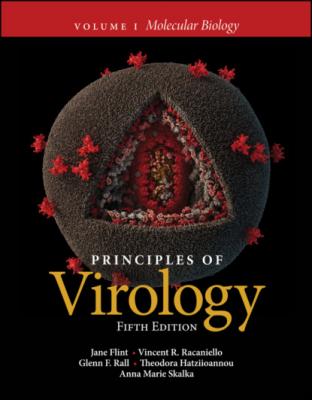Principles of Virology, Volume 1. Jane Flint
Читать онлайн.| Название | Principles of Virology, Volume 1 |
|---|---|
| Автор произведения | Jane Flint |
| Жанр | Биология |
| Серия | |
| Издательство | Биология |
| Год выпуска | 0 |
| isbn | 9781683673606 |
An important paper that shows how to estimate 50% endpoints in titrations of viruses in animals.
Guo F, Li S, Caglar MU, Mao Z, Liu W, Woodman A, Arnold JJ, Wilke CO, Huang TJ, Cameron CE. 2017. Single-cell virology: on-chip investigation of viral infection dynamics. Cell Rep 21:1692–1704.
A seminal paper that presents a pneumatic device for measuring infection of single cells with poliovirus and its use to measure the heterogeneity of infection.
STUDY QUESTIONS
1 Which of the following statements is not correct?The infectious cycle and virus reproduction are synonymousA susceptible cell has a functional receptor for a given virusA cell that is resistant to infection has the viral receptor but the virus cannot be reproduced in itVirus can be reproduced in a permissive cellA susceptible and permissive cell is the only cell in which a virus can enter and be reproduced
2 Which of the following statements about cytopathic effects (CPE) is correct?Some viruses may not produce cytopathic effects in certain cellsSyncytium formation is a type of CPERounding up and detachment of cultured cells is a type of CPEFormation of a viral plaque depends upon CPEAll of the above
3 Which of the following assays determines the number of infectious viral particles?ELISAHemagglutination assayPlaque assayHigh-throughput sequencingPolymerase chain reaction
4 If one million infectious virus particles are added to a culture dish of one million cells, which of the following will happen:Each cell will receive one virus particle because the MOI is 1None of the cells will receive any virus particles37% of the cells are uninfectedOnly one infectious cycle will take placeNone of the above
5 When doing a plaque assay, what is the purpose of adding a semisolid agar overlay on the monolayer of infected cells?To stabilize progeny virionsTo ensure that cells remain susceptible and permissiveTo act as a pH indicatorTo keep cells adherent to the plate during incubationTo restrict viral diffusion after lysis of infected cells
6 In the particle-to-PFU ratio, “particle” can best be described as:One of the proteins which makes up the virionA virus which may or may not be infectiousA virus which is infectiousA virus which is not infectiousElementary or composite
7 The plaque assay plate below was made from a dilution of 10–6 and 0.1 ml of the dilution was plated on the cell monolayer. What is the titer in PFU/ml?
8 Explain why no infectious viruses are observed in the cell culture medium during the latent phase of a onestep growth curve.
9 You infect a plate of one million cells at an MOI of 100. The particle-to-PFU ratio for this virus is 1,000. How many total virus particles did you add to the cells?
3 Genomes and Genetics
Genome Principles and the Baltimore System
Structure and Complexity of Viral Genomes DNA Genomes RNA Genomes
What Do Viral Genomes Look Like?
What Can Viral Sequences Tell Us?
The “Big and Small” of Viral Genomes: Does Size Matter?
Genetic Analysis of Viruses Classical Genetic Methods Engineering Mutations into Viral Genomes Engineering Viral Genomes: Viral Vectors
LINKS FOR CHAPTER 3
Virocentricity with Eugene Koonin http://bit.ly/Virology_Twiv275
CRISPR-Cas immune systems https://www.microbe.tv/twim/twim-184/
… everywhere an interplay between nucleic acids and proteins; a spinning wheel in which the thread makes the spindle and the spindle the thread.
ERWIN CHARGAFF, 1955
Introduction
Earth abounds with uncountable numbers of viruses of great diversity. However, because taxonomists have devised methods of classifying viruses, the number of identifiable groups is manageable (Chapter 1). One of the contributions of molecular biology has been a detailed analysis of the genetic material of representatives of major virus families. From these studies emerged the principle that the viral genome is the nucleic acid-based repository of the information needed to build, reproduce, and transmit a virus (Box 3.1). These analyses also revealed that the thousands of distinct viruses defined by classical taxonomic methods can be organized into seven groups, based on the structures of their genomes.
Genome Principles and the Baltimore System
A universal function of viral genomes is to specify proteins. However, none of these genomes encode the complete machinery needed to carry out protein synthesis. Consequently, one important principle is that all viral genomes must be copied to produce messenger RNAs (mRNAs) that can be read by host ribosomes. Literally, all viruses are parasites of their host cells’ translation system.
A second principle is that there is unity in diversity: evolution has led to the formation of only seven major types of viral genome. The Baltimore classification system integrates these two principles to construct an elegant molecular algorithm for virologists (Fig. 3.1). When the bewildering array of viruses is classified by this system, we find seven pathways to mRNA. The value of the Baltimore system is that by knowing only the nature of the viral genome, one
